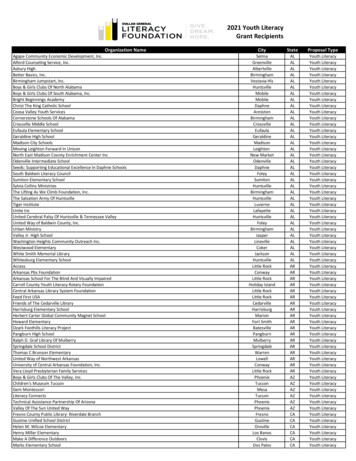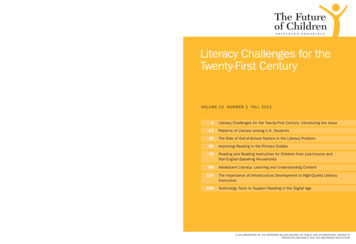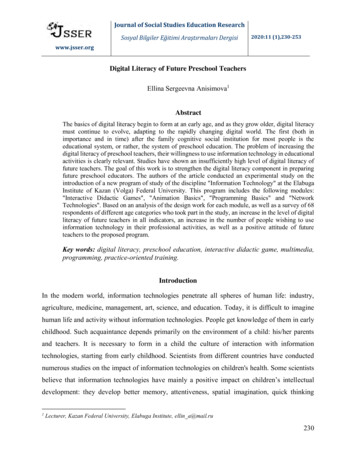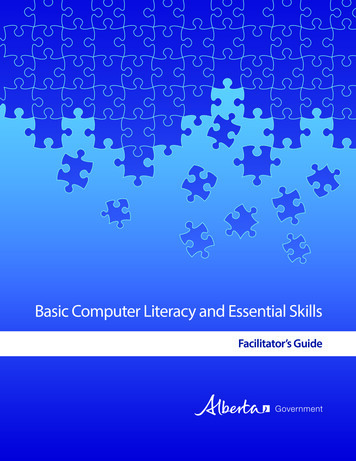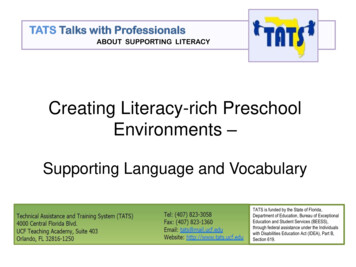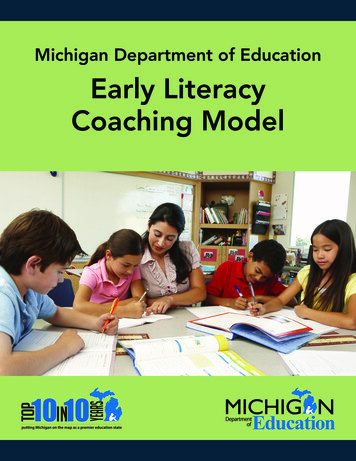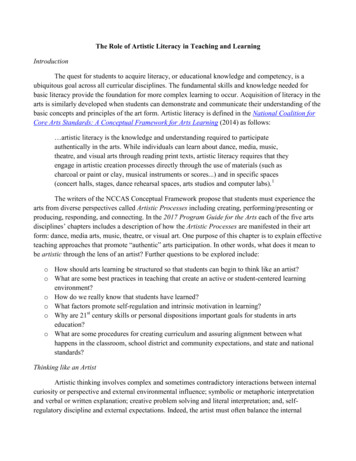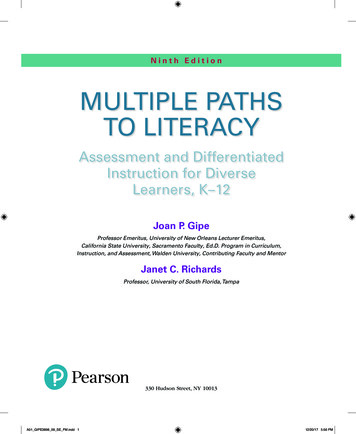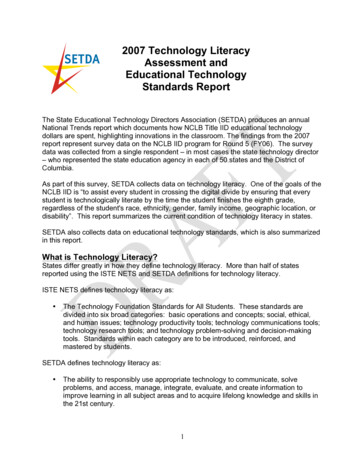
Transcription
2007 Technology LiteracyAssessment andEducational TechnologyStandards ReportThe State Educational Technology Directors Association (SETDA) produces an annualNational Trends report which documents how NCLB Title IID educational technologydollars are spent, highlighting innovations in the classroom. The findings from the 2007report represent survey data on the NCLB IID program for Round 5 (FY06). The surveydata was collected from a single respondent – in most cases the state technology director– who represented the state education agency in each of 50 states and the District ofColumbia.As part of this survey, SETDA collects data on technology literacy. One of the goals of theNCLB IID is “to assist every student in crossing the digital divide by ensuring that everystudent is technologically literate by the time the student finishes the eighth grade,regardless of the student's race, ethnicity, gender, family income, geographic location, ordisability”. This report summarizes the current condition of technology literacy in states.SETDA also collects data on educational technology standards, which is also summarizedin this report.What is Technology Literacy?States differ greatly in how they define technology literacy. More than half of statesreported using the ISTE NETS and SETDA definitions for technology literacy.ISTE NETS defines technology literacy as: The Technology Foundation Standards for All Students. These standards aredivided into six broad categories: basic operations and concepts; social, ethical,and human issues; technology productivity tools; technology communications tools;technology research tools; and technology problem-solving and decision-makingtools. Standards within each category are to be introduced, reinforced, andmastered by students.SETDA defines technology literacy as: The ability to responsibly use appropriate technology to communicate, solveproblems, and access, manage, integrate, evaluate, and create information toimprove learning in all subject areas and to acquire lifelong knowledge and skills inthe 21st century.1
Twenty-one states reported that they use the ISTE NETS definition, fifteen states reportedusing a unique state definition, eight states reported using the SETDA definition, andseven states reported that they used another method for defining technology literacy. Asindicated by the survey results, technology literacy is not uniformly defined by all states.Figure 1 shows a summary of how states define technology literacy and Figure 2 showshow each state defines technology literacy.Figure 1 – Summary of How States Define Technology Literacy21ISTE NETS definition15Unique state definition8SETDA definition7Other0510Number of states1520Source: SETDA Fall 2007 SurveyFigure 2 – How Each State Defines Technology LiteracyStateAlabamaAlaskaDefinitionISTE NETS DefinitionUnique StateDefinitionArizonaUnique StateDefinitionArkansasCaliforniaISTE NETS DefinitionUnique E NETS DefinitionSETDA DefinitionCommentTechnology literacy and proficiency is the ability of an individualto use technology effectively, appropriately, and responsibly toacquire lifelong knowledge and skills.Ability to responsibly use appropriate technology tocommunicate, solve problems, create products and access,manage, integrate, evaluate, and create information to improvelearning in all subjects, to use information to improve learning.Ability to responsibly use appropriate technology tocommunicate, solve problems, and access, create, integrate,evaluate, and manage information to improve learning of statecontent standards in all subject areas and to acquire lifelongknowledge and skills in the 21st century.SETDA definition with minor modifications2
StateD.C.FloridaDefinitionISTE NETS DefinitionSETDA DefinitionGeorgiaUnique StateDefinitionHawaiiIdahoIllinoisISTE NETS DefinitionISTE NETS DefinitionUnique StateDefinitionIndianaIowaSETDA dSETDA DefinitionISTE NETS DefinitionISTE NETS DefinitionSETDA DefinitionUnique StateDefinitionMassachusettsUnique StateDefinitionMichiganUnique ISTE NETS DefinitionISTE NETS DefinitionSETDA DefinitionOtherCommentFlorida Technology Literacy Profile: Ability to responsibly useappropriate technology to communicate, solve problems, andaccess, manage, integrate, evaluate, and create information toimprove learning in all subject areas and to acquire lifelongknowledge and skills in the 21st century.http://www.fldoe.org/BII/Instruct Tech/downloads/FLTechLiteracyProfile.pdfAbility of students to use the tools of their society with skill in anethical, accurate, and insightful manner to meet the demands ofthe 21st Century workplace and world. This includes the abilityto use appropriate technology responsibly to solve problemsand to create knowledge and learning by: accessing; managing;evaluating and analyzing; integrating and synthesizing; andcommunicating information.Technology literate is the ability to contribute effectively in aglobal society through the appropriate use of technology tosolve problems, to communicate, to collaborate, and to connectinformation, ideas, and learning.Defined by each district supported by the Area EducationAgency.Technology literacy is defined as the ability of an individual,working independently and with others, to responsibly,appropriately and effectively use technology tools to access,manage, integrate, evaluate, create and communicateinformation.Three broad standards: Basic Operations, Concepts, andProductivity Tools; Digital Citizenship, Ethics, Society, andSafety; and Research and Information Fluency; CriticalThinking, Problem Solving & Decision Making; Communicationand Collaboration; and Creativity and s/itstand draft.docTechnology literacy is the ability to responsibly use appropriatetechnology to communicate, solve problems, and access,manage, integrate, evaluate, and create information to improvelearning in all subject areas and to acquire lifelong knowledge.The state uses TAGLIT as a measurement devise with a scoreof "3" or better indicating literacy.3
StateNebraskaNevadaNewHampshireDefinitionISTE NETS DefinitionISTE NETS DefinitionUnique StateDefinitionNew JerseyUnique StateDefinitionNew MexicoNew YorkISTE NETS definitionOtherNorth CarolinaNorth DakotaISTE NETS definitionUnique StateDefinitionOhioUnique StateDefinitionOklahomaOregonISTE NETS DefinitionSETDA DefinitionPennsylvaniaOtherRhode IslandSouth CarolinaSouth DakotaISTE NETS DefinitionISTE NETS DefinitionUnique StatedefinitionCommentICT Literacy Standards describe a K-12 program for all publicschools. ICT is integrated with core content, students createdigital portfolios, 8th grade portfolios are assessed, and 1/2credit of ICT is required for uickref.pdfAll students will use computer applications to gather andorganize information and to solve problems.http://education.state.nj.us/cccs/? standard matrix;c 8Technology literacy is:1. An understanding of the concepts behind computingequipment, network connectivity, and application software;2. The skills to responsibly use appropriate technology toaccess, synthesize, evaluate, communicate, and createinformation to solve problems and improve learning in all subjectareas; and3. The ability to acquire new knowledge for on-going andlifelong learning in the 21st century global workplace.North Dakota has used its Library/Technology Literacystandards: research, developing products usingmedia/technology, technological systems, collaborativeskills/independent learning/personal enjoyment, and ethical,legal, and social ech.pdfAchievement of State of Ohio Technology Academic ContentStandards. Seven standards: Nature of Technology;Technology and Society Interaction; Technology for ProductivityApplications; Technology and Communication Applications;Technology and Information Literacy; Design; and es/Pages/ODE/ODEDetail.aspx?page 3&TopicRelationID 339&ContentID 1279&Content 32802The Oregon Educational Technology Evaluation Task Force ifreviewing the definition of technology literacy in light of therelease of the ISTE NETS for Students and the new State Boardrevisions to high school diploma requirements.Pennsylvania has not formally adopted a Technology Literacydefinition; however, for the purposes of EETT, PA requires thatLEA adopt local standards that meet or exceed the ISTE NETS.Technology literacy is the ability to responsibly use appropriatetechnology to communicate, solve problems, and access,manage, integrate, evaluate, and create information to improve4
StateDefinitionCommentlearning in all subject areas and to acquire lifelong knowledgeand skills in the 21st century.TennesseeTexasISTE NETS DefinitionOtherUtahVermontVirginiaISTE NETS definitionISTE NETS definitionUnique StateDefinitionWashingtonUnique StateDefinitionWest VirginiaWisconsinWyomingOtherSETDA definitionOtherTechnology literacy is the ability to responsibly use appropriatetechnology to communicate, solve problems, and access,manage, integrate, evaluate, and create information to improvelearning in all subject areas and to acquire lifelong knowledge.The possession and use of technology skills to communicate,solve problems, and access, create, integrate, evaluate, andmanage information to improve the learning of state contentstandards in all subject areas and to acquire lifelong knowledge.Ability to responsibly, creatively, & effectively use appropriatetechnology to: communicate; access, collect, manage, integrate,& evaluate information; solve problems & create solutions; build& share knowledge; and improve & enhance learning.A combination of both the ISTE and SETDA definitions.The State does have a unique definition of technology literacy,however the State also used the ISTE NETS definition to fine tofine tune the State definition.8th Grade Technology Literacy AssessmentsForty-three states (84 percent) reported that 8th grade technology literacy assessments areconducted at the local level and not at the state level. Eight states (16 percent) reportedconducting state-level 8th grade technology literacy assessments – Arizona, Hawaii,Louisiana, Maryland, Mississippi, North Carolina, South Carolina, and South Dakota.Figure 3 – 8th Grade Technology Assessments at the State versus Local Level4340Number of states30201080State LevelLocal LevelSource: SETDA Fall 2007 Survey5
8th Grade Technology Literacy Assessments MethodsStates vary widely in the methods used for conducting 8th grade technology literacyassessments. Ten percent of states reported using a content-based approach forassessing technology literacy. Four states reported that 8th grade technology literacy isembedded in overall current state assessments. Another four states reported usingperformance test (web-based) methods, and another four states reported using atechnology course. Finally, two states utilized knowledge tests (web-based) methods andone state reported using knowledge tests (non-web-based) methods. Fifty-nine percent ofstates reported using a different method than the ones surveyed for assessing 8th gradetechnology literacy. Figure 4 shows a summary of methods used for assessing 8th gradetechnology literacy and Figure 5 shows the methods that each state is using for 8th gradetechnology literacy assessments.Figure 4 - Methods for Conducting 8th Grade Technology Literacy AssessmentsSource: SETDA Fall 2007 SurveyFigure 5 – 8th Grade Technology Literacy Assessment Methods byState8%Embedded in current state testContent based projectPerformance test (web-based)Knowledge test (non-web-based)Knowledge test (web-based)Technology aStand Alone KnowledgeAssessments Non-WebBasedOtherMultiple methods. Some districts are standards-basedAlaska6
StateArizonaMethodArkansasCaliforniaStand Alone PerformanceTests lawareD.C.FloridaHawaiiIdahoIllinoisContent Based ProjectTechnology CourseStand Alone PerformanceTests Web-BasedStand Alone PerformanceTests Web-BasedContent Based ProjectContent Based neMarylandOtherEmbedded in the CurrentState AssessmentStand Alone KnowledgeAssessments ents(QSM) and have technology standards andassessments.The state uses Tec Literacy Assessment created byLearning.com.Assessed by various methods at the LEA levelStand alone self assessment on performance andknowledgeDistricts are responsible for assessing technologicalliteracy using a state approved assessment method.Those methods are: Program based, Paper pencil,Performance based, Portfolio, Projects, Onlineassessment programLEAs choice. LEAs detail the evaluation process intheir technology plans.Illinois is a local control state and it is the responsibilityof the district to determine if a student is technologyliterate.Schools can demonstrate through multiple methodsChecklists, observations, portfolio, tests, coursecompletion, district developed assessmentNo one method, severalTechnology literacy is not uniformly assessed in thestate, although the state is working on it. Somedistricts conduct their own measurements using someof the above strategies.Local districts decide on how to assess studentliteracy. Technology in Massachusetts, page Local decision. Districts use all assessments describedexcept for "embedded in current state assessment"Local assessments based on local school districtchoice. Required by law to embed information andtechnology literacy skills within our academic contentstandards, impacting assessment in future years.The process to assess technology literacy is currentlybeing created.7
StateMethodCommentsMissouriContent Based ProjectMontanaNebraskaOtherOtherDistricts use a variety of methods with content-basedprojects being the most prevalent. The next widelyused method is a middle school technology exploratorycourse.TAGLITLocal districts use their own assessments and theNebraska rubric of essential technology conditions.NevadaNewHampshireTechnology CourseOtherNew JerseyNew MexicoOtherEmbedded in the CurrentState AssessmentOtherNew YorkNorth CarolinaNorth DakotaStand Alone PerformanceTests Web-BasedTechnology aOtherRhode IslandSouth CarolinaOtherStand Alone KnowledgeAssessments Web-BasedEmbedded in the CurrentState AssessmentSouth y CourseOtherVirginiaOtherICT Literacy Standards. ICT is integrated with corecontent, students create digital portfolios, 8th gradeportfolios are assessed, and 1/2 credit of ICT isrequired for graduation.Local district decision.LEAs decide how they will approach the expectation ofassessing studentsSchool districts use an eighth grade course or fullyintegrate technology into the curriculum in all areas.Varies by LEALocal assessments, including observationsAll Competitive Grant awardees use the PETI tool forevaluating their grants. Formula districts use a varietyof assessments including LoTi and district developedtools.LEA utilize multiple instruments to assess tech literacy,including all of the above plus portfolios, observations,etc.As defined by the LEABoth embedded in other content area and newlypiloted stand alone test based on new ed-techstandardsLEAs determine assessments.Not assessed at this time.A set of Performance Assessment tasks have beendeveloped and are optionally available to schools.The Commonwealth of Virginia assesses eighth-gradetechnology literacy at the state level during thecomputer-based Standards of Learning assessmentseach fall and spring. LEAs must provide informationon the alignment of local technology plans to theVirginia Technology Plan, including methods forassessing computer literacy.8
StateMethodCommentsWashingtonOtherDetermined by each district. State provides freeoptional Student Technology Literacy Self-AssessmentTool at http://www.edtech.wednet.edu/pilotjr/West VirginiaWisconsinEmbedded in the CurrentState AssessmentContent Based ProjectWyomingOtherOverwhelming majority of LEAs use multiple methods.Most common are grade level subject/content base.Local control state. Each LEA is responsible for theirown assessment, tailored to their individual needs.Technology StandardsStates provided information on what frameworks were used to guide the states’ policiesand standards for educational technology. Many states utilized more than one framework.The ISTE NETS for students, teachers, and administrators was used most often by states.Figure 6 shows how often the various frameworks were used to guide states’ policies andstandards for educational technology.Figure 6 – Frameworks Used to Guide Policies and Standards for EducationalTechnologyISTE NETS for StudentsISTE NETS for TeachersISTE NETS for AdministratorsPartnership for 21st Century SkillsEnGauge 21st Century SkillsEnGauge Six Essential ConditionsState standardsOtherSETDA resourceCEO Forum StarChartSeven DimensionsCEO Forum 21st Century LearningSETDA PETI ToolsOther state’s frameworkState legislative languageState er of states50Source: SETDA Fall 2007 SurveySetting and Assessing Technology StandardsSetting and assessing technology standards varies widely among students, educators, andadministrators. For Students in K-12 schools, 24 percent of states have set and assessedstandards and an additional 58 percent of states have standards in place, but not yetassessed. For PreK-12 teachers, 12 percent of states have standards in place andassessed and an additional 32 percent have standards in place, but not yet assessed.9
Twenty-eight percent of states reported that technology standards were in place, but notassessed for PreK-12 administrators and 19 percent of states reported that technologystandards for teacher educators were in place, but not assessed.Forty percent of states reported that there are no state standards for technology for PreK12 teachers. The trend continues with Pre-service teachers and PreK-12 Administrators,with almost 50 percent of states reporting that state standards for technology are not inplace. For teacher educators, the numbers are even higher with 63 percent of statesreporting that state standards are not in place (Figure 7).Figure 7 – State Standards and Assessments for Students, Teachers, andAdministratorsStudents in K-12 SchoolsPreK-12 TeachersPreService TeachersPreK-12 AdministratorsTeacher Educators02040Percent6080100State standards are:In place & assessedIn place, but not yet assessedCurrently under considerationNOT in placeDon't knowSource: SETDA Fall 2007 SurveyLevel of State Support to LEAs when Implementing TechnologyStandardsThirty-three states reported providing some type of state support to LEAs whenimplementing technology standards. Five states reported providing both professionaldevelopment and technical assistance to LEAs when implementing technology standards.Thirteen states reported providing technical assistance to LEAs and fifteen states reportedproviding professional development to LEAs when implementing technology standards.Figure 8 lists the states that provide support to LEAs when implementing technologystandards.Figure 8 – Type of State Support Provided to LEAs when Implementing TechnologyStandardsStateType of Support10
raskaNew HampshireNew JerseyNorth CarolinaOklahomaOregonPennsylvaniaRhode IslandSouth DakotaTennesseeUtahVermontWashingtonWest VirginiaWisconsinWyomingType of SupportProfessional DevelopmentTechnical AssistanceProfessional DevelopmentBothTechnical AssistanceProfessional DevelopmentProfessional DevelopmentProfessional DevelopmentTechnical AssistanceTechnical AssistanceProfessional DevelopmentTechnical AssistanceTechnical AssistanceProfessional DevelopmentTechnical AssistanceTechnical AssistanceProfessional DevelopmentProfessional DevelopmentTechnical AssistanceProfessional DevelopmentTechnical AssistanceProfessional DevelopmentBothProfessional DevelopmentProfessional DevelopmentTechnical AssistanceProfessional DevelopmentProfessional DevelopmentProfessional DevelopmentTechnical AssistanceBothBothTechnical AssistanceTechnical Assistance11
ISTE NETS defines technology literacy as: The Technology Foundation Standards for All Students. These standards are divided into six broad categories: basic operations and concepts; social, ethical, and human issues; technology productivity tools; technology communications tools; technology research tools; and technology problem-solving and .
